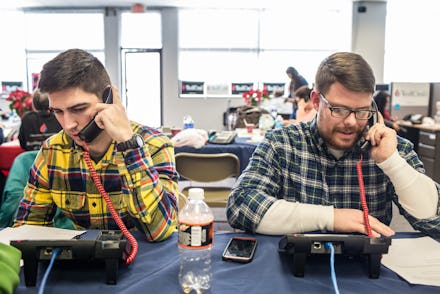Which polls are best? 5 questions every voter needs to ask when reading election polls

News reporters, political pundits and campaign staffers are watching the polls closely in this contentious presidential election, hoping that each percentage point on any given day will move the needle enough to put one candidate solidly ahead of the other.
Just two months away, the 2016 election between Republican Donald Trump and Democrat Hillary Clinton is certainly a close one. Several recent polls show Trump ahead by a few points, others show Clinton ahead by a few points.
For voters, it can be difficult to make sense of it all.
Here are five things that every concerned voter should ask when considering the impact of a political poll.
Who conducted and paid for the poll?
Always look at the source of the poll to determine if there is any bias behind how it was conducted. "There's a ton of pollsters," writes Harry Enten in his guide to reading polls for FiveThirtyEight. "Many are staffed with really smart people who put a lot of thought and resources into producing top-quality surveys. Some are not. Some produce fake polls. If you've never heard of the polling firm, be suspicious." If you're not sure if a polling firm is legitimate or not, there are several rankings online that can tell you their trustworthiness.
How many people were interviewed?
It's always important to look at not only how many people were included in the poll, but what kind of people. Some polls specifically look at certain groups based on age, party affiliation, where they live, whether they are registered voters and so on. Some experts say that finding reliable sample groups has become more difficult over the years, as more people abandon landlines in favor of cell phones, and often ignore calls through caller ID. "I think polling is unquestionably less accurate now than it was 10 years ago and certainly 20 years ago or 30 years ago," Dave Cooley, of Cooley Public Strategies, told the The Nashville Ledger.
When was the poll conducted?
The timing of a poll is key. A poll released earlier this month by CNN/ORC showed Republican nominee leading Democrat Hillary Clinton by two percentage points. Many reporters and political pundits immediately cried foul. Why? The poll was taken over Labor Day weekend, when many voters were on vacation, leaving many to question the whether the pool of respondents accurately represented the population it was taken from. Also, it's important to take note of the timing of a poll for a few other reasons, such as whether it was conducted before or after an event or press conference that could influence the respondent's answer.
What is the margin of error?
Because polls are taken from a sample of the population, pollsters always account for a margin of error since they can't survey the entire population. The margin of error is a key factor to look at, especially when a poll shows support sliding up or down by just a few percentage points. Often the margin of error itself can make a poll less trustworthy because the numbers are just too close to give one candidate a statistically significant lead over another. "News reports about polling will often say that a candidate's lead is 'outside the margin of error' to indicate that a candidate's lead is greater than what we would expect from sampling error, or that a race is 'a statistical tie' if it's too close to call," explains Andrew Mercer for the Pew Research Center.
What questions were asked and how were they worded?
Words matter when it comes to political polls. How a question is phrased can influence a person's answer. It's easy to read a headline about the latest poll, but it's often worthwhile to look at the poll itself to see what kinds of questions were asked. The order of questions also matters, as explained by CBS News' Sarah Dutton in her 2012 guide to polling: "Some polls ask the 'horserace' question (which candidate the voter supports) at the beginning of the questionnaire, so the vote question isn't affected by other questions, while others ask it further into the questionnaire. This can sometimes be a reason why polls show different results."